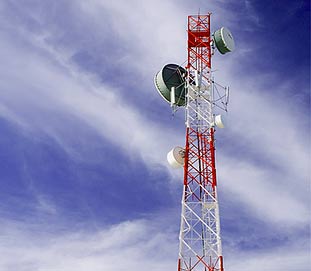High-frequency electromagnetic waves can cause infertility, evidenced by soldiers working at radar stations with outdated equipment that leak waves, often experiencing difficulties in conceiving. This type of wave also surrounds ordinary citizens, emanating from TVs, refrigerators, computers, mobile phones, microwaves, and more.
Recently, residents in various areas of Hanoi have been continuously “crying out for help” regarding mobile service providers installing transmission towers right in residential neighborhoods, as they believe electromagnetic waves will harm their health. According to Dr. Nguyen Khac Hai, Director of the Institute of Occupational Medicine and Environmental Health, this fear is not unfounded, as numerous studies have demonstrated that high-frequency electromagnetic waves have a detrimental impact on health.
 |
| (Photo: Flickr) |
Electromagnetic waves, when passing through the body, can cause cells to rub against each other, generating heat; the temperature can rise to the point of boiling bodily fluids and cooking cells (microwaves operate on this principle). At very high doses, electromagnetic waves can cause acute harm. For instance, a worker repairing radar, standing right in front of the transmitting unit, could faint immediately if someone else unknowingly turns the machine on. If the dose is low or the distance is not close enough, the effects of electromagnetic waves can accumulate over time, impacting the nervous system, reproductive health, cardiovascular system, and eyesight.
Some domestic studies show that postal workers in broadcasting areas are prone to health disturbances, exhibiting symptoms such as dull skin, constant fatigue, poor appetite, insomnia, and memory loss. Surveys within the military indicate that radar personnel have a high incidence of infertility.
The Earth itself is also an object that emits electromagnetic waves. The “thoughtfulness” of nature equips humans with the ability to adapt to these natural waves. On the other hand, at moderate levels, electromagnetic waves can also be beneficial to health. However, the increasing presence of electrical devices in households forces people to live amidst dense electromagnetic waves, which inevitably have adverse effects on health if individuals do not take protective measures.
To ensure safety for citizens, developed countries have established standards for electromagnetic waves in residential and industrial areas. However, in Vietnam, standards have only been issued for workplace environments, and there are currently no regulations on permissible levels of electromagnetic waves in residential areas. Meanwhile, mobile transmission towers continue to proliferate, even close to residential homes. According to requests from some families living near transmission stations in Linh Dam, Dinh Cong, and My Dinh (Hanoi), the Institute of Occupational Medicine and Environmental Health measured electromagnetic waves inside and outside their homes, with results indicating that the levels remained within safe limits (according to global recommendations). However, these results do not reassure residents or experts, as they are merely isolated cases.
To date, there has never been an official survey on electromagnetic waves in residential areas in Vietnam, thus no one can confirm that residents living near mobile phone, radio, or television transmission stations are not at risk of cancer, infertility, cataracts, etc. Moreover, even if surveys show that wave levels are excessively high, it is still challenging to compel the owners of these stations to rectify the situation due to the absence of established standards.
Dr. Nguyen Khac Hai believes that currently, with modern technical equipment that does not leak waves, the risk for technicians at transmission stations is not as high as before. However, for the general public, the danger is increasingly significant due to being surrounded by numerous dense electromagnetic waves emitted nearby. In response to this concern, the Institute of Occupational Medicine and Environmental Health has officially recommended that the Ministry of Health conduct specific research to assess high-frequency electromagnetic pollution (telecommunications radio waves) and its effects on the health of urban residents. The institute also urges the Ministry to quickly establish standards for electromagnetic radiation in residential areas.
Ways to Mitigate the Effects of Electromagnetic Waves
All electrical devices emit electromagnetic waves, and their impact depends on intensity, frequency, and distance. Among these, only distance is a factor we can control. Therefore, the best way is to avoid areas emitting electromagnetic waves, especially high-voltage power stations (220 kV and above), as the waves here are very strong. When the 500 kV North-South power line was newly constructed, a study was conducted on its effects on local residents and workers, and it was found that there was no acute toxicity. However, no surveys have been conducted regarding long-term effects. Thus, it is best not to build homes near high-voltage areas, with a minimum distance of 7 meters.
Children should not use mobile phones, as their waves can affect development, especially reproductive organs. Adults should also avoid keeping these devices on their beds. Men are advised to refrain from carrying mobile phones in their pockets.
Old or faulty microwaves should be replaced as the waves from them can significantly affect humans. The microwave door has a metal mesh that helps absorb waves; however, if the door is open, safety is compromised. For safety, it is best not to stand too close to the microwave while it is operating, and do not look inside to check the food, as microwaves can damage the lens of the eye.
However, Dr. Hai also advises people not to be overly fearful of the effects of electromagnetic waves from household appliances, as their intensity is not high. If the devices are new and in good condition, they are safe. Additionally, the intensity of electromagnetic waves decreases rapidly with distance.
Hai Ha


















































